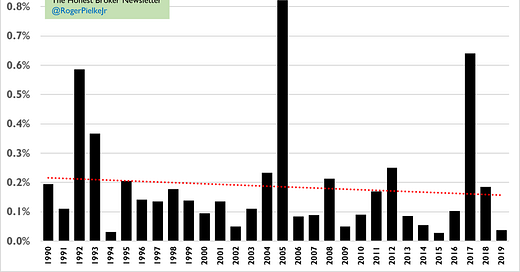Yesterday, the Center for Emergency Management and Homeland Security at Arizona State University released an update of its database on U.S. disaster losses, the Spatial Hazard Events and Losses Database for the United States (SHELDUS). This is the dataset used by the Federal Emergency Management Agency (FEMA) to estimate expected annual losses from disasters in the U.S. — for 2021 FEMA expected $141 billion in disaster losses. The loss estimates from SHELDUS and FEMA cannot be compared to the “billion dollar disasters” from NOAA (see here for an explanation).
The SHELDUS data, like others, indicate a decline in U.S. disaster losses since 1990 as a proportion of U.S. GDP (data via OMB). Measuring disaster costs as a fraction of GDP is the recommended methodology of the United Nations under its Sendai Framework for Disaster Risk Reduction. The U.S. is part of a broader global trend of declining vulnerability to weather and climate extremes, which has been documented around the world and for a wide range of weather and climate phenomena. This is good news, but the downward trend will not continue without continued attention to disaster risk reduction.





Adjust for population size as well. The cost per person has been declining even faster. US population increased from 248 to 330 million over this period. May also want to consider time prices in addition to inflation adjusted prices in order to more fully capture innovation.